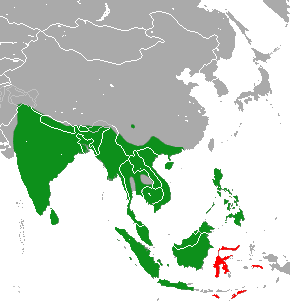Paradoxurus
| Paradoxurus[1] | |
|---|---|

| |
| Asian palm civet (Paradoxurus hermaphroditus) | |
| Scientific classification | |
| Domain: | Eukaryota |
| Kingdom: | Animalia |
| Phylum: | Chordata |
| Class: | Mammalia |
| Order: | Carnivora |
| Suborder: | Feliformia |
| Family: | Viverridae |
| Subfamily: | Paradoxurinae |
| Genus: | Paradoxurus Cuvier, 1822 |
| Type species | |
| Viverra hermaphrodita[2] Pallas, 1777
| |
| Species | |
|
see table | |

| |
| Paradoxurus ranges | |
Paradoxurus is a genus of three palm civets within the viverrid family that was denominated and first described by Frédéric Cuvier in 1822.[3] The Paradoxurus species have a broad head, a narrow muzzle with a large rhinarium that is deeply sulcate in the middle. Their large ears are rounded at the tip. The tail is nearly as long as the head and body.[4]
The three species are the Asian palm civet, the Golden palm civet, and the Brown palm civet.[1]
Characteristics
[edit]Paradoxurus species have a broad head, a narrow muzzle with a large rhinarium that is deeply sulcate in the middle. Their large ears are rounded at the tip, the interior ridges and bursae are well developed. The skull exhibits marked muscular moulding, and the postorbital area is deeply constricted shortly behind the well-developed postorbital processes. It is considerably narrower than the interorbital area and than the muzzle above the canines. The dental formula is 3.1.4.23.1.4.2. The palate is not produced behind to cover the anterior half of the mesopterygoid fossa, and is flat and expanded between the posterior cheek teeth. The tail is nearly as long as the head and body, sometimes quite as long, and about six times as long as the hind foot.[4]
Taxonomy
[edit]As of 2005, this genus was defined as comprising three species native to Southeast Asia:[1]
| Name | Image | Distribution |
|---|---|---|
| Asian palm civet, P. hermaphroditus (Pallas, 1777)[5] |  |

|
| Golden palm civet, P. zeylonensis Pallas, 1778[6] |  |
Sri Lanka |
| Brown palm civet, P. jerdoni Blanford, 1885[7] |  |
Western Ghats, India |
In 2009, it was proposed to also include the golden wet-zone palm civet (P. aureus, Cuvier, 1822), the Sri Lankan brown palm civet (P. montanus, Kelaart, 1852) and the golden dry-zone palm civet (P. stenocephalus, Groves et al., 2009), which are endemic to Sri Lanka.[8] A subsequent study found very low genetic diversity and no geographical structure within the golden palm civet and did not support the proposed split.[9] Comparison of morphological data indicate that the Asian palm civet comprises three major clades that should be recognized as separate species: namely one in the Indian subcontinent and Southeast Asia (as Paradoxurus hermaphroditus sensu stricto), one in Sumatra, Java and other small islands (Paradoxurus musanga), and the third in the Philippines and the Mentawai Islands (Paradoxurus philippensis).[9] Genetic data, however, do not support species level distinction.[10]
References
[edit]- ^ a b c Wozencraft, W. C. (2005). "Genus Paradoxurus". In Wilson, D. E.; Reeder, D. M. (eds.). Mammal Species of the World: A Taxonomic and Geographic Reference (3rd ed.). Johns Hopkins University Press. pp. 550–551. ISBN 978-0-8018-8221-0. OCLC 62265494.
- ^ Wilson, D. E.; Reeder, D. M., eds. (2005). Mammal Species of the World: A Taxonomic and Geographic Reference (3rd ed.). Johns Hopkins University Press. ISBN 978-0-8018-8221-0. OCLC 62265494.
- ^ Cuvier, F. (1822). "Du genre Paradoxure et de deux espèces nouvelles qui s'y rapportent". Mémoires du Muséum d'Histoire Naturelle Paris. 9: 41–48.
- ^ a b Pocock, R. I. (1939). "Paradoxurus". The Fauna of British India, including Ceylon and Burma. Vol. 1. Mammalia. London: Taylor and Francis. pp. 379–415.
- ^ Pallas, P. S. (1778). "Das Zwitterstinkthier". In Schreber, J. C. D. (ed.). Die Säugethiere in Abbildungen nach der Natur, mit Beschreibungen. Erlangen: Wolfgang Walther. p. 426.
- ^ Pallas, P. S. (1778). "Der Boshond". In Schreber, J. C. D. (ed.). Die Säugethiere in Abbildungen nach der Natur, mit Beschreibungen. Erlangen: Wolfgang Walther. p. 451.
- ^ Blanford, W. T. (1885). "A Monograph of the Genus Paradoxurus, F. Cuvier". Proceedings of the Zoological Society of London. 53 (4): 780–808. doi:10.1111/j.1096-3642.1885.tb02921.x.
- ^ Groves, C. P.; Rajapaksha, C.; Mamemandra-Arachchi, K. (2009). "The taxonomy of the endemic golden palm civet of Sri Lanka" (PDF). Zoological Journal of the Linnean Society. 155: 238–251. doi:10.1111/j.1096-3642.2008.00451.x.
- ^ a b Veron, G.; Patou, M.-L.; Tóth, M.; Goonatilake, M.; Jennings, A. P. (2015). "How many species of Paradoxurus civets are there? New insights from India and Sri Lanka". Journal of Zoological Systematics and Evolutionary Research. 53 (2): 161–174. doi:10.1111/jzs.12085.
- ^ Duckworth, J.W.; Timmins, R.J.; Choudhury, A.; Chutipong, W.; Willcox, D.H.A.; Mudappa, D.; Rahman, H.; Widmann, P.; Wilting, A. & Xu, W. (2016). "Paradoxurus hermaphroditus". IUCN Red List of Threatened Species. 2016: e.T41693A45217835.
External links
[edit] Media related to Paradoxurus at Wikimedia Commons
- "Paradoxurus". ASM Mammal Diversity Database. American Society of Mammalogists. Retrieved 3 June 2019.